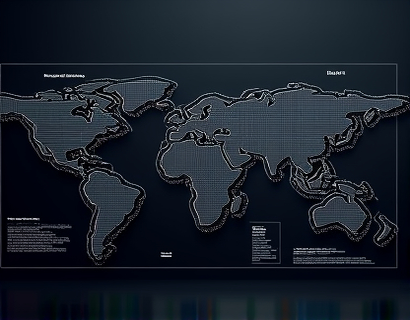Advanced Software for Graph Theory and Fluid Dynamics: Empowering Insights for Complex System Analysis
In the realm of complex system analysis, the integration of advanced software solutions for graph theory and fluid dynamics has revolutionized the way researchers and engineers approach intricate problems. These sophisticated tools are designed to streamline complex data analysis, enhance visualization, and drive innovative discoveries in mathematical modeling and fluid mechanics. For professionals in these fields, the availability of precise analysis and unparalleled insights provided by these tools is invaluable, facilitating groundbreaking advancements that were previously unattainable.
Graph Theory Software: Unraveling Complex Networks
Graph theory, a branch of mathematics that studies the properties of graphs, which are collections of vertices connected by edges, plays a crucial role in modeling and analyzing various complex systems. From social networks to transportation systems, graph theory provides a powerful framework for understanding relationships and interactions. Advanced software for graph theory enables researchers to handle large and intricate networks with ease, offering a suite of functionalities that simplify the process of data analysis and visualization.
One of the key features of these software tools is their ability to perform extensive calculations on graph properties such as connectivity, centrality, and clustering. These calculations are essential for identifying critical nodes and edges within a network, which can have significant implications in fields like epidemiology, where understanding the spread of diseases through social contacts is crucial. The software can also simulate various scenarios, allowing researchers to predict the impact of changes in the network structure, such as the addition or removal of nodes or edges.
Visualization is another critical aspect of graph theory software. Complex networks can be challenging to comprehend in their raw form, but advanced visualization techniques transform these networks into intuitive and interpretable graphical representations. Interactive visualizations enable users to explore different aspects of the network, zoom in on specific regions, and dynamically adjust parameters to observe changes in real-time. This capability is particularly useful for educational purposes, as it helps students and researchers gain a deeper understanding of network dynamics.
Fluid Dynamics Software: Simulating and Analyzing Fluid Behavior
Fluid dynamics, the study of fluids in motion, is fundamental to understanding a wide range of natural and engineered systems, from weather patterns to the flow of blood in the human body. Advanced software for fluid dynamics provides researchers and engineers with powerful tools to simulate and analyze fluid behavior under various conditions. These tools are essential for optimizing designs, predicting performance, and ensuring safety in applications such as aerospace, automotive, and environmental engineering.
One of the most significant advantages of modern fluid dynamics software is its ability to solve complex partial differential equations that govern fluid flow. Methods such as the Finite Element Method (FEM) and the Computational Fluid Dynamics (CFD) are implemented in these tools, allowing for accurate and efficient simulations. These methods discretize the governing equations into a set of algebraic equations that can be solved numerically, providing detailed insights into the behavior of fluids in both steady and unsteady states.
Visualization plays a crucial role in fluid dynamics software as well. Advanced visualization techniques enable users to observe and analyze flow patterns, pressure distributions, and velocity fields in a comprehensive manner. Color-coded contour plots, streamline visualizations, and vector fields provide a clear and intuitive representation of fluid behavior, making it easier to identify critical regions and phenomena such as turbulence and vortices. These visualizations are not only valuable for research but also for communicating results to non-expert stakeholders.
Integration of Graph Theory and Fluid Dynamics
The integration of graph theory and fluid dynamics software creates a synergistic approach to complex system analysis. For instance, in the study of porous media flow, graph theory can be used to model the connectivity of pores, while fluid dynamics software simulates the flow through these pores. This combined approach allows for a more comprehensive understanding of the system, as it captures both the structural properties of the medium and the dynamic behavior of the fluid.
Another area where this integration is particularly impactful is in the field of multiphase flow, where multiple fluids with different properties interact within a system. Graph theory can help model the interfaces and interactions between different phases, while fluid dynamics software simulates the motion and behavior of each phase. This integrated approach is essential for applications such as oil recovery, where understanding the movement of oil and water through porous rock is critical for optimizing extraction processes.
Enhancing Research and Engineering Workflows
The adoption of advanced software for graph theory and fluid dynamics has significantly enhanced research and engineering workflows. These tools automate many time-consuming tasks, allowing researchers to focus on higher-level analysis and interpretation. For example, automating the generation of mesh grids in fluid dynamics simulations reduces the time and effort required to set up experiments, enabling more iterations and a deeper exploration of parameter spaces.
Moreover, these software solutions often come with extensive libraries and pre-built models, which can be easily customized or extended to suit specific research needs. This modularity ensures that users can leverage existing knowledge and build upon it, accelerating the development of new theories and applications. The ability to share and collaborate on models and simulations through cloud-based platforms further enhances the collaborative nature of scientific research.
Case Studies and Real-World Applications
To illustrate the practical impact of these advanced software tools, consider a few real-world applications. In the field of epidemiology, graph theory software has been used to model the spread of infectious diseases, helping public health officials design more effective intervention strategies. By simulating different scenarios and analyzing the impact of various factors such as vaccination rates and social distancing measures, researchers can provide data-driven recommendations to mitigate the spread of diseases.
In the automotive industry, fluid dynamics software is crucial for optimizing vehicle aerodynamics. Advanced simulations help engineers design cars with reduced drag, leading to improved fuel efficiency and performance. For instance, the use of CFD simulations in the design of electric vehicles has been instrumental in optimizing battery placement and cooling systems, ensuring optimal thermal management and extending the vehicle's range.
In environmental engineering, the combined use of graph theory and fluid dynamics software has been applied to model and mitigate the effects of pollution in water bodies. By modeling the flow of pollutants through river networks and simulating the dispersion of contaminants, researchers can identify critical areas for intervention and develop strategies to protect ecosystems and public health.
Future Directions and Challenges
As the complexity of systems continues to grow, the demand for more advanced and sophisticated software solutions in graph theory and fluid dynamics will only increase. Future developments in these fields are likely to focus on enhancing computational efficiency, improving accuracy, and expanding the range of applicable problems. Machine learning and artificial intelligence are expected to play a significant role in these advancements, enabling more intelligent and adaptive simulation techniques.
However, there are also challenges to address. One major challenge is the need for user-friendly interfaces that can accommodate users with varying levels of expertise. While advanced users may require detailed control over simulation parameters, researchers and engineers with less technical background should also be able to leverage these tools effectively. Developing intuitive graphical user interfaces and providing comprehensive documentation and support will be crucial in making these software solutions accessible to a broader audience.
Another challenge is the integration of multi-scale and multi-physics simulations, where different physical phenomena and length scales need to be considered simultaneously. This requires the development of more sophisticated algorithms and numerical methods that can handle the increased complexity without sacrificing accuracy or performance.
Conclusion
The advancement of software solutions for graph theory and fluid dynamics has transformed the landscape of complex system analysis, offering researchers and engineers powerful tools to unravel intricate problems and drive innovation. By streamlining data analysis, enhancing visualization, and facilitating groundbreaking discoveries, these tools are essential for making significant contributions to mathematical modeling and fluid mechanics. As the field continues to evolve, the integration of cutting-edge technologies and the development of user-friendly interfaces will ensure that these software solutions remain at the forefront of scientific and engineering research.










































